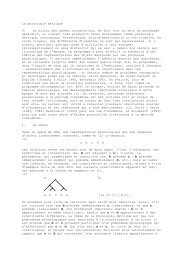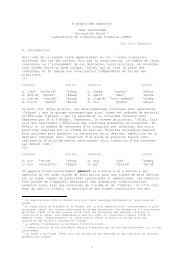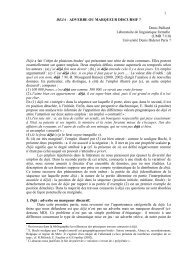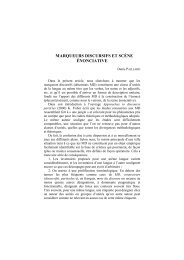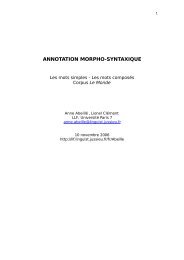CV as the only syllable type Jean Lowenstamm
CV as the only syllable type Jean Lowenstamm
CV as the only syllable type Jean Lowenstamm
Create successful ePaper yourself
Turn your PDF publications into a flip-book with our unique Google optimized e-Paper software.
consonantal position.<br />
The point can be made even sharper with <strong>the</strong> examples of (16f,g). In (21),<br />
I have given <strong>the</strong> underlying representation of [sIma] "listen !, ms." (21a), and<br />
[simä] "listen !, fem." (21b).<br />
(21)<br />
a. b.<br />
C V C V C V<br />
C V C V C V<br />
\ | \ /<br />
s m A<br />
\ | \ /<br />
s m A + I<br />
A labial is not a suitable docking site; nei<strong>the</strong>r is a root-initial coronal, two<br />
simple facts about Chaha. Thus, no consonant palatalization is observed. Instead,<br />
a long vowel, i: is heard. If long vowels are to be represented <strong>as</strong> I have<br />
advocated, <strong>the</strong>n <strong>the</strong> medial C position to which m is linked in (21) is now<br />
straddled by i: in (22). Accordingly, m must move to <strong>the</strong> rightmost binyanic C<br />
position, thus inhibiting branching of A. This is shown in (22).<br />
(22)<br />
C V C V C V<br />
\ \ / | \<br />
s I m A<br />
[simä]<br />
The striking fact about [sIma] and [simä] is that, in each c<strong>as</strong>e, one and <strong>only</strong><br />
one, peripheral/long vowel can be accomodated at a time. The exact location of<br />
that vowel matters little: it can appear to <strong>the</strong> right of C 2 <strong>as</strong> in [sIma], or to <strong>the</strong> left<br />
of C 2 <strong>as</strong> in [simä]. What does matter is that two peripheral/long vowels, such <strong>as</strong><br />
in hypo<strong>the</strong>tical *[sima], cannot coexist. It is e<strong>as</strong>y to see from (21a) and (22) why<br />
<strong>the</strong> binyan is saturated by one single long vowel. It remains a challenge under<br />
any o<strong>the</strong>r analysis. Generalizing from this example, I submit that (23) obtains.<br />
(23)<br />
Law of Binyanic saturation (LBS)<br />
If <strong>the</strong> makeup of a binyan involves x consonantal positions,<br />
that binyan can accomodate, at most, x:2 long vowels<br />
That is, a triconsonantal binyan will fit no more than one long vowel, a<br />
quadriconsonantal binyan will fit no more than two long vowels, etc. LBS<br />
follows trivially <strong>as</strong> a mere consequence of <strong>the</strong> mode of representation of long<br />
vowels advocated here. Its remarkable feature is that <strong>the</strong> number of long vowels<br />
a given binyan can fit can be expressed in terms of <strong>the</strong> number of its consonantal



